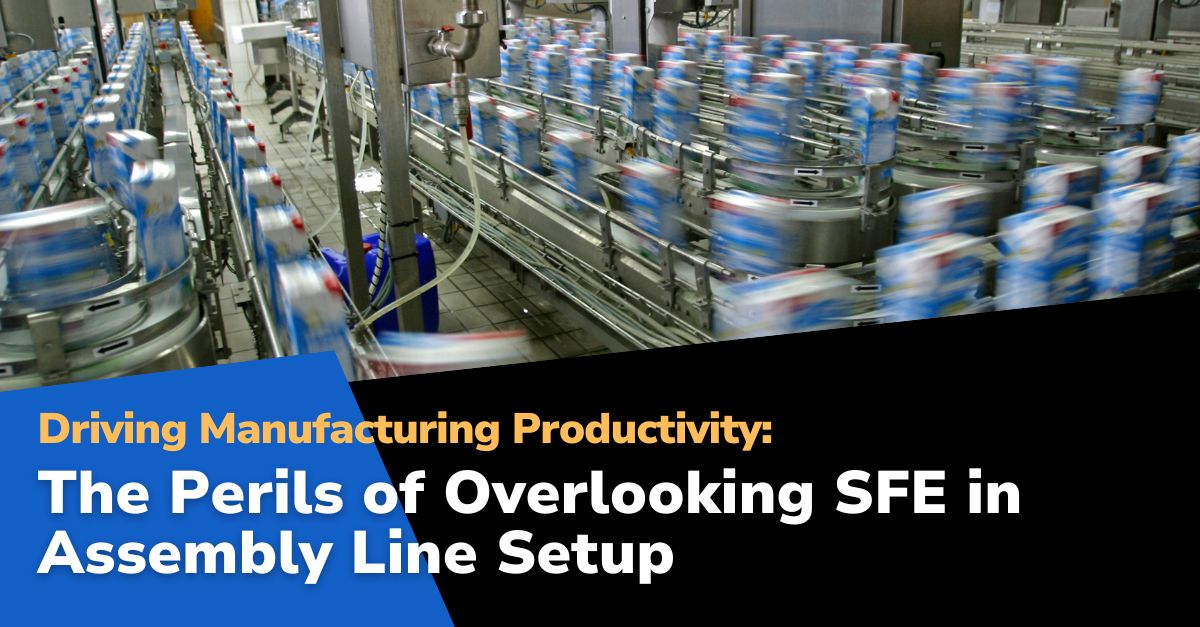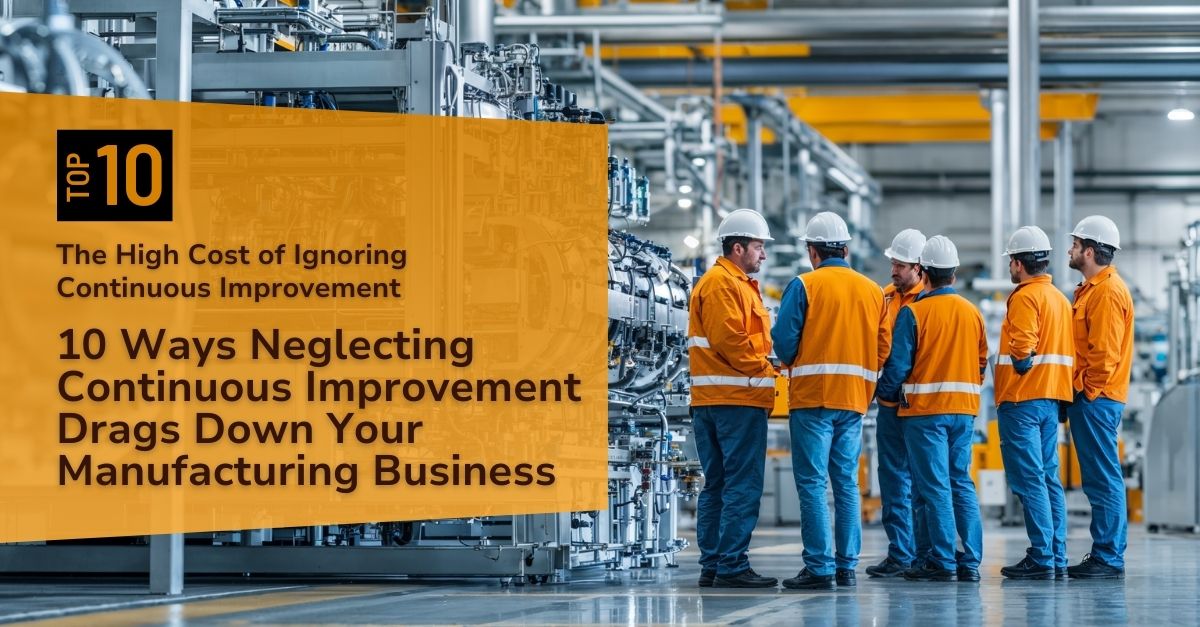
In today’s competitive manufacturing environment, your assembly line setup is either helping you stay ahead, or quietly dragging you behind. A poorly designed or outdated setup can create a chain reaction of inefficiencies, draining resources, limiting output, and eroding customer trust. This first installment in our ten-part Shop Floor Excellence (SFE) series breaks down the top 10 hidden costs of inefficient assembly lines, and what manufacturers can do to turn things around.
1Production Delays:
When workstations aren’t properly balanced or material flow is inconsistent, even minor interruptions can add up to significant production delays. These aren’t just schedule slip-ups, they cascade into late shipments, overtime costs, and strained supplier relationships. In some cases, entire shifts lose productivity due to delays that could have been prevented with better setup and planning.
Solution: Use real-time monitoring and predictive analytics to flag bottlenecks early, enabling faster adjustments and minimizing disruptions before they derail the line.
2Increased Cycle Times:
Cycle time is the heartbeat of your assembly process. Without balance across stations, you’ll see idle time at some points and overload at others. When teams are waiting on materials, sharing tools, or performing excessive movement due to layout inefficiencies, every second adds up, reducing output and driving up labor costs.
Solution: Reassess workstation layout and process flow to ensure each station completes work within the ideal takt time. Use time studies to pinpoint where steps can be streamlined or eliminated entirely.
3Wasted Resources:
Poor assembly line setups often lead to excess material handling, scrap, and rework. Tools may be misplaced, parts may arrive in the wrong sequence, or energy use spikes due to inefficient machine cycles. These hidden wastes are hard to track without a deliberate system in place, and they chip away at profitability.
Solution: Implement lean manufacturing tools like 5S, value stream mapping, and standard work to reduce motion waste, excess inventory, and downtime. Focus on first-pass quality to minimize rework loops.
4Elevated Overhead Costs:
When inefficiencies force you to throw more people or hours at the problem just to meet output goals, overhead costs balloon. Supervisors spend more time troubleshooting than leading. Maintenance gets reactive instead of preventative. And indirect costs like overtime, training, and absenteeism begin to climb.
Solution: Identify tasks that can be simplified, standardized, or automated. Use workforce planning tools and KPIs to ensure labor is aligned with actual demand, not covering for process failures.
5Reduced Throughput:
Even if machines are running and people are working, that doesn’t mean you’re hitting full throughput potential. Poor sequencing, long changeovers, or lack of synchronization between shifts can lead to frequent slowdowns, especially when production must stop to wait for upstream corrections.
Solution: Use demand-driven scheduling and digital dashboards to coordinate production in real time. Reduce downtime by implementing SMED (Single-Minute Exchange of Dies) to shorten changeover windows.
6Lower Product Quality:
Disorganized processes create room for error. Operators working with unclear instructions, inconsistent parts, or outdated equipment are more likely to produce defects. Over time, these quality issues show up as warranty claims, rejected shipments, or costly recalls, all of which damage both revenue and reputation.
Solution: Standardize quality checkpoints throughout the line and incorporate operator feedback into process improvements. Track defect data by workstation to identify recurring patterns and prevent them.
7Compromised Worker Safety:
Cramped workspaces, poor lighting, trip hazards, or unclear material flow can all increase the risk of injuries. On top of that, when workers are constantly navigating obstacles or cutting corners to meet quotas, the risk of safety violations climbs fast. Even a single injury can disrupt operations for weeks.
Solution: Design for safety by involving frontline workers in layout planning. Ensure compliance with OSHA standards and invest in ergonomic tools and clear signage to reduce the chance of accidents.
8Decreased Worker Morale:
A frustrating work environment, full of delays, rework, or unpredictable changes, takes a toll on your people. Burnout rises when teams feel like they’re constantly catching up, putting out fires, or dealing with the same avoidable issues day after day. Low morale also increases turnover and absenteeism.
Solution: Give employees more control over their workspace and engage them in continuous improvement initiatives. Recognize team wins, reduce friction points, and provide clear expectations supported by tools that help, not hinder, daily work.
9Inflexibility to Market Changes:
In today’s landscape, being locked into a rigid assembly line setup can quickly become a liability. If you can’t switch between products easily or scale up/down based on demand shifts, you’ll miss growth opportunities, or get stuck with excess inventory. Customization requests or small batch runs become logistical headaches instead of agile wins.
Solution: Build flexibility into your system with modular workstations, universal tooling, and cross-trained operators. Use data from your DPS to monitor changeover frequency and identify where bottlenecks occur during product transitions.
10Diminished Brand Reputation:
It doesn’t take long for recurring delays, defects, or customer complaints to damage your reputation. Whether you’re a supplier in a tight supply chain or a consumer-facing brand, consistency is king. Once customers lose confidence, it’s difficult, and expensive, to win it back.
Solution: Apply the principles of SFE across your entire operation, from layout and labor to metrics and materials. A well-executed production line supports your brand promise by delivering on time, every time.
The POWERS Difference:
Synchronizing Your Shop Floor for Success
At POWERS, we’ve worked with manufacturers across industries to uncover the operational friction points hidden inside their assembly lines. We don’t just suggest best practices, we walk the floor with your team to identify where flow is breaking down and where performance is stalling. Our proven approach to Shop Floor Excellence aligns process, people, and systems to deliver measurable, sustainable results.
Our Digital Production System (DPS) gives frontline supervisors and plant leaders the visibility and tools they need to take control of day-to-day performance.
With DPS, your team gets real-time insights into cycle time deviations, labor productivity, material availability, and output targets, all in one dashboard. This enables faster decisions, tighter execution, and more confident leadership on the floor.
You Don’t Have to Guess Where the Waste Is
If your line feels slow, your labor seems stretched, or your team is spending more time firefighting than producing, let’s pinpoint the real cause and fix it. We’ll bring clarity to what’s holding your production back, and we’ll give your team the tools, systems, and confidence to drive real improvement every day.
To step into the future of efficient manufacturing, reach out to our team at +1 678-971-4711 or email us at info@thepowerscompany.com. Let’s choreograph your operations to the rhythm of success.
Continue Reading from this Mastery Series
- Part 1 - The Perils of Overlooking SFE in Assembly Line Setup
- Part 2 - A Lackluster Approach to Shop Floor Excellence Impacts Workforce Engagement —
- Part 3 - The Consequences of Sidestepping Data-Driven Decisions in Shop Floor Excellence
- Part 4 - Without Shop Floor Excellence, Product Quality Can Drop Like a Rock
- Part 5 - A Lack of Commitment to Shop Floor Excellence Can Lead to These 10 Safety Issues
- Part 6 - Shop Floor Excellence Makes Your Operation More Agile, Flexible, and Adaptable to Market Changes
- Part 7 - Bridging the Gap with Effective Communication in Shop Floor Excellence
- Part 8 - How Ignoring Shop Floor Excellence Undermines Continuous Improvement
- Part 9 - Tackling Inefficient Energy and Material Use with Shop Floor Excellence
- Part 10 - Enhancing Customer Focus Through Shop Floor Excellence







